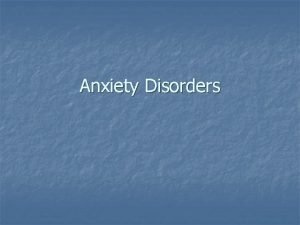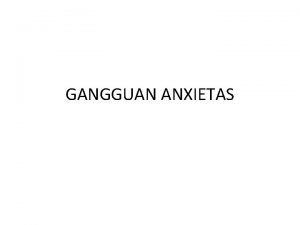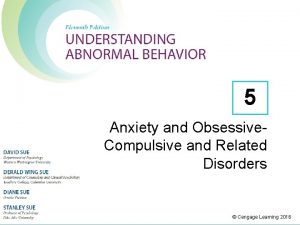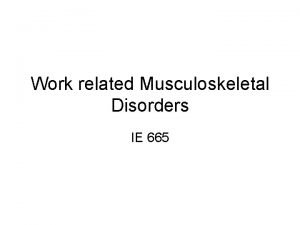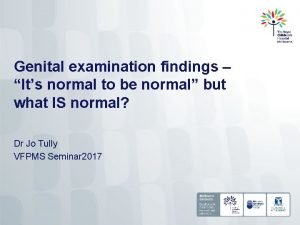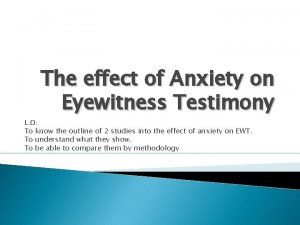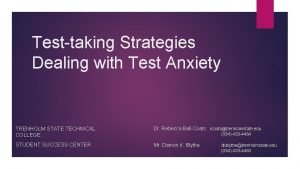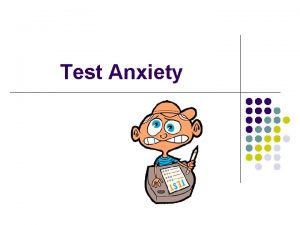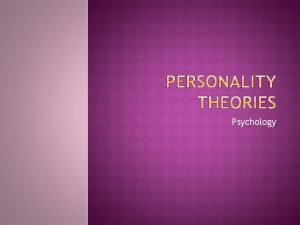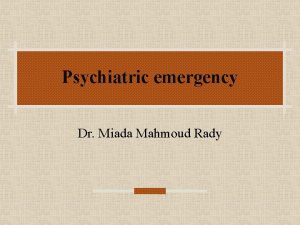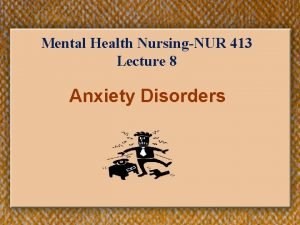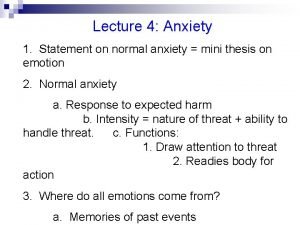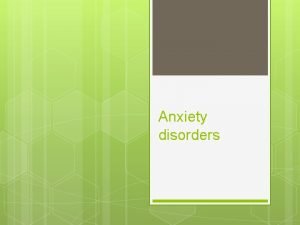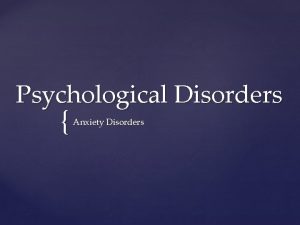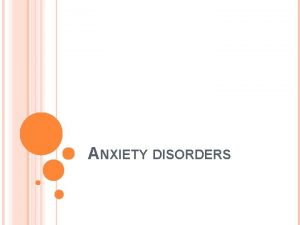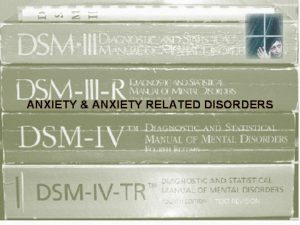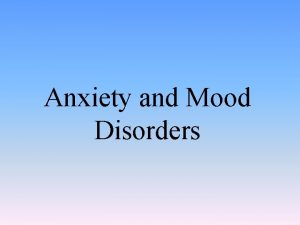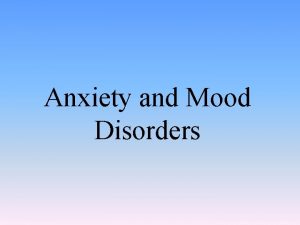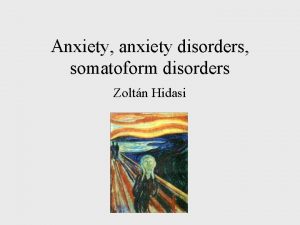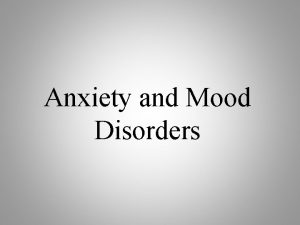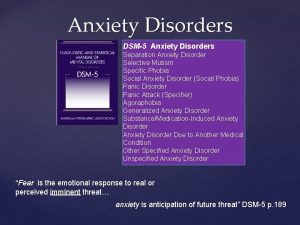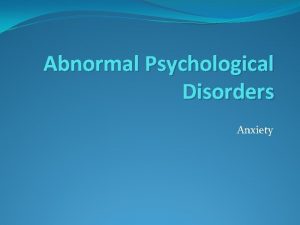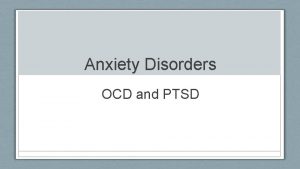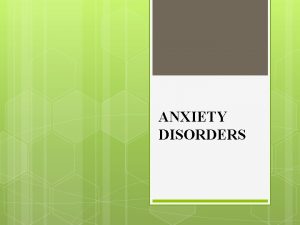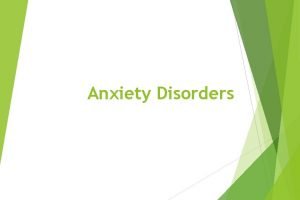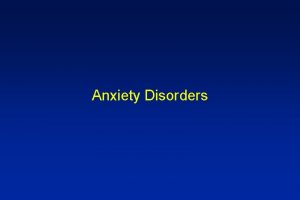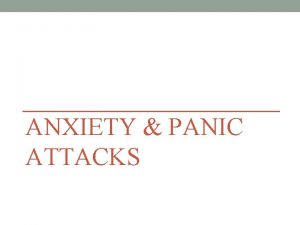Anxiety disorders Definition Anxiety is a normal response


















- Slides: 18

Anxiety disorders

Definition Anxiety is a normal response to stressful or fearful circumstances causing activation of neurobiological systems that allows an individual to adapt or manage the stressful situation. Anxiety disorder occur when the anxiety is excessive leading to irrational behavior or thinking or functioning. AD are chronic with high rate of relapse.

Classification AD are classified according to type, severity of symptoms, and course of illness into: v Generalized anxiety disorders GAD(adulthood). v Panic disorders PD. (adulthood) v Social anxiety disorders SAD. (in childhood and teenagers) fear of social interaction. 90%of patients with anxiety disorders have lifetime history of other psychiatric disorders (mainly depression)

Aetiology and pathophysiology

Locus ceruleus (LC): a region in the brain, containing NE producing cells, increase activity of the cells will increase anxiety. Yohimbin ↑ activity of LC and ↑ anxiety. Ø Serotonergic system: Raphe nuclei: 5 -HT producing neurons has a complicated role in regulating the activity of cells in LC, overtime the activity of 5 -HT cells in raphe nuclei inhibits firing of noradrenergic cells in LC. Ø

Cont. GABA: GABAergic drugs are used for acute anxiety reduction, but the lack of specific target for their effects lead to undesirable effects. Ø HPA Corticotropin releasing hormone and cortisone regulate the effect of anxiety on the body and provide +ve feedback to the brain. Ø Neuropeptides: Eg. Neuropeptide Y (NPY) and substance P. NPY reduces the effects of stress hormone and inhibits activity of LC. Sub P anxiolytic and antidepressants. Ø

Clinical presentation of GAD Restlessness, easily fatigues, poor conc. , irritability, muscle tension, and insomnia. 3 of the above symptoms occurring more days than not for at least 6 months.

Medical conditions that cause anxiety: Psychatric: Alcohol or sub. Use or withdrawal. Neurologic CV, (CVA, seizure). respiratory(asthma), endocrine (hyper hypothyroidism).

Medications associated with anxiety Anticonvulsant drugs. Antidepressants. Decongestants (pseudoephedrine). Stimulants (amphetamine). Corticosteroids.

Treatment of GAD Psychotherapy and/or pharmacotherapy pharmacologic therapy: 1 - Antidepressants are the drug of choice for: § Chronic GAD (because tolerable SE and no risk of dependence). § Efficient in comorbid conditions (depression). 2 - Benzodiazepines are used in the following: • Acute relief is needed. • Adjuvant. • Sleep disturbances 3 - others: buspiron, hydroxyzine. o

Treatment alogorithm

Antidepressants: SSRI, SNI, TCAs: SSRI (fluoxitin), SNRI (venlafaxine) has similar tolerability and both are tolerated than TCA which have many SE. Benzodiazepines: They enhance the transmission of inhibitory neurotransmitter GABA. All are expected to produce equivalent benefit when given in comparable doses but they differ in pharmacokinetic and potency for GABA receptor site.

Benzodiazepines (BZ)are metabolized by hepatic oxidation but lorazepam and oxazepam bypass hepatic oxidation and are preferable for patients with reduced hepatic function secondary to aging or disease.

SE of benzodiazepines CNS depression (sedation). Cognitive effects (poor memory, anterograde amnesia-difficulty to remember recent events-), which occur more with high potency BZ (lorazepam, alprazolam). Rapid discontinuation leads to withdrawal.

Withdrawal should be gradual since abrupt withdrawal may cause confusion, psychosis, convulsion, insomnia. This may develop until up to 3 weeks of stopping long acting benzodiazepine (nitrazepam, diazepam), but may occur within hours in case of short acting(temazepam).

Steps of withdrawal Withdrawal can be in steps 1/4 of daily dose every 5 -7 days until reach ½ the original dose then decrease by 1/10 every fortnight until discontinuation. Withdrawal phenomenon is more common with the short acting than the long acting. Some drugs like propranolol can be used for treating the withdrawal. Sedative and hypnotics should be avoided.

others Buspirone: 5 - HT 1 A partial agonist and reduces presynaptic 5 -HT firing. No abuse, no withdrawal, no treatment of comorbid disease. Has gradual onset of action THO used as a 2 nd line therapy. SE: nausea, headache. DI: its conc. increases with enz. inhibitors (erythromycine) and decreases with enzyme inducers (rifampicin).

Hydroxyzine: No treatment of comorbid conditions (depression) and mainly used for somatic rather than psychic symptoms of anxiety). Pregabalin: For somatic and psychic symptoms , no treatment of depression, excreted renally. Causes euphoria and risk of withdrawal, therefore caution in patient with past history of substance abuse.
 Chapter 15 anxiety and obsessive-compulsive disorders
Chapter 15 anxiety and obsessive-compulsive disorders Anxiety disorders def
Anxiety disorders def Icd 10 anxiety with panic attacks
Icd 10 anxiety with panic attacks Multipath model of anxiety disorders
Multipath model of anxiety disorders Natural response and forced response
Natural response and forced response Natural response circuit
Natural response circuit Primary immune response and secondary immune response
Primary immune response and secondary immune response Work related musculoskeletal disorders definition
Work related musculoskeletal disorders definition It's normal to be normal
It's normal to be normal How anxiety affects eyewitness testimony
How anxiety affects eyewitness testimony Relaxation techniques test anxiety
Relaxation techniques test anxiety Anxiety symptoms
Anxiety symptoms I'm a perfect example of someone who has math anxiety
I'm a perfect example of someone who has math anxiety Neurotic anxiety example
Neurotic anxiety example Anxiety mnemonic
Anxiety mnemonic Nursing diagnosis for panic disorder
Nursing diagnosis for panic disorder Examples of generalized anxiety disorder
Examples of generalized anxiety disorder Chapter 8 managing stress and anxiety
Chapter 8 managing stress and anxiety Neurotic anxiety example
Neurotic anxiety example

